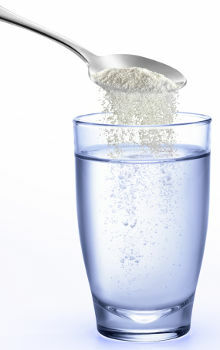An extremely common fact during food preparation is to miss the amount of salt or sugar added to them. You've probably already eaten a food that was too salty or low in salt, or you've probably already had a juice that was extremely sweet or low in sugar.
This happens because, in most cases, the salt or sugar content that should be added to a particular food or drink is not respected. The amount of salt or sugar dissolved in a certain solvent is called concentration of a Mix homogeneous or, simply, concentration of the solution.
In a homogeneous mixture, we have the presence of at least two different chemical substances: the solute (such as salt or sugar) and the solvent. For this reason, the concentration of a homogeneous mixture is closely related to solubility, that is, the ability of a given matter to dissolve another.
Solubility, however, is an extremely limited factor, as each material has a specific ability to dissolve. different materials, that is, a material will never dissolve the amount we want, but what is related to its limit. In 100 ml of water, for example, only 36 grams of table salt (NaCl) and 197 grams of sugar can be dissolved.

In the mixture of water and sugar, water is the solvent, and sugar, the solute
The homogeneous mixture can be classified according to the concentration it can present. Look:
The) Saturated solution: is the homogeneous mixture in which the amount of solute dissolved is the maximum supported by the solvent.
B) Unsaturated solution: it is the homogeneous mixture in which the amount of solute dissolved is below the maximum that the solvent can dissolve.
Concentrated solution: is the unsaturated solution whose amount of dissolved solute is close to the maximum that the solvent can dissolve.
Diluted solution: it is the saturated solution whose amount of dissolved solute is well below the maximum that the solvent can dissolve.
To calculate the concentration of a homogeneous mixture, just weigh the mass of the solute that was used and divide it by the volume of the solvent, which results in the following formula:
C = m1
V
C = concentration of homogeneous mixture
m1 = mass of solute
V = used volume
Example: To know the concentration of powdered chocolate dissolved in milk water when we mix 15 grams of it in 300 mL of milk, just use these data in the concentration formula.
Powdered chocolate mass to be used: 15 grams
Volume of milk to be used: 300 mL or 0.3L
C = 15
300
C = 0.05 g/ml
or
C = 15
0,3
C = 50 g/L
Knowing that the solubility of powdered chocolate is 30 grams in 300 mL of milk (whose concentration would be 0.1 g/mL), we can state that the homogeneous mixture prepared by exercise should be classified in relation to concentration as an unsaturated solution diluted. Therefore, the chocolate flavor in this milk would not be intense, given that it was at half the concentration.
Respecting the concentration of a homogeneous mixture is a point that makes us avoid waste, since, if the solvent has already reached its saturation, it's no use adding more solute because it won't dissolve anymore no grams. When preparing coffee, a lot of solid material is wasted because people do not respect the solubility indicated on the package.
Unfortunately, you hardly ever see a person weighing, for example, the salt or sugar they will use in preparing food. Respecting their concentration in a mixture is essential, as excessive consumption of salt or sugar can trigger several health problems, such as:
diabetes (in the case of sugar only)
hypertension
kidney overload
cardiovascular diseases
obesity (in the case of sugar only)
By Me. Diogo Lopes Dias



